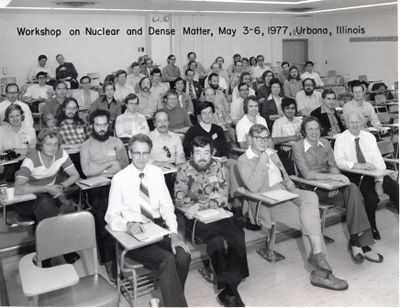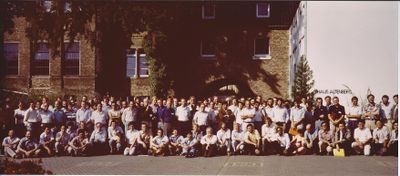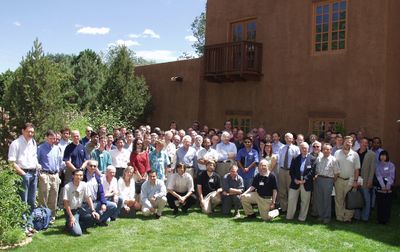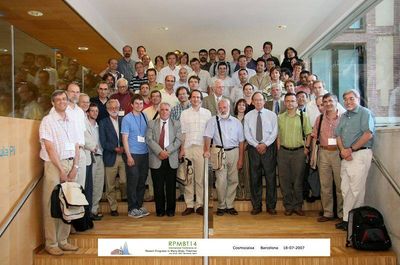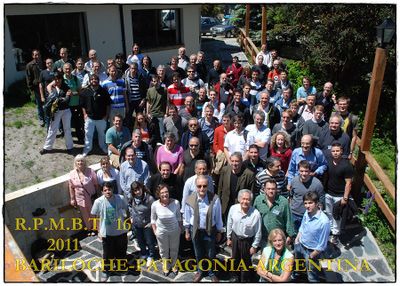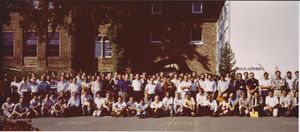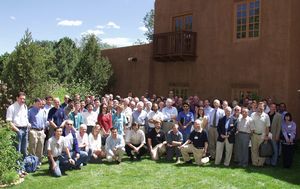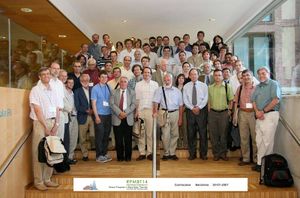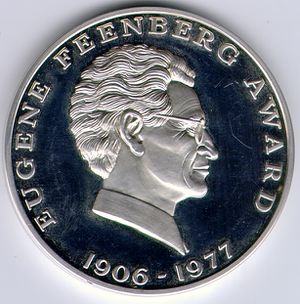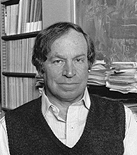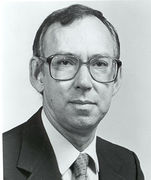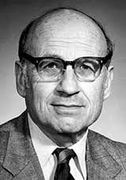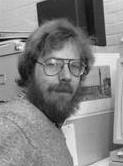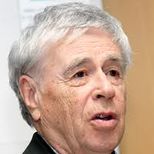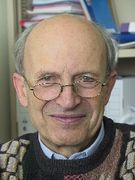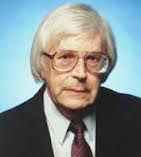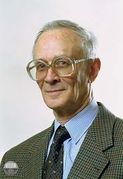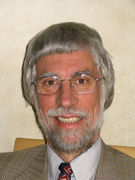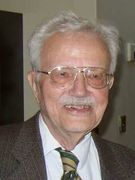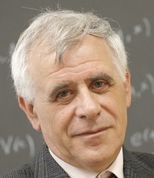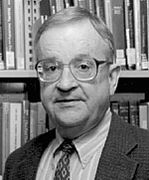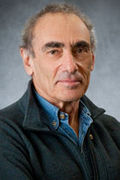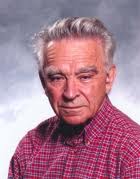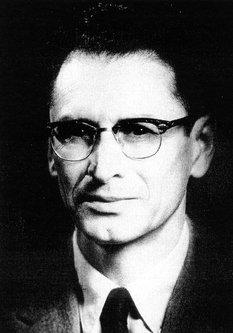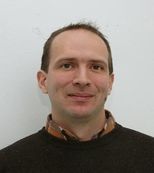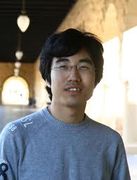Recent Progress in Many Body Theories:Main Page
Contents
RECENT PROGRESS IN MANY-BODY THEORIES (RPMBT)
The conference series on Recent Progress in Many-Body Theories (RPMBT) is now firmly established as the premier series of international meetings in the field of many-body physics. The conferences offer an ideal opportunity to recognize important achievements and to showcase significant new results in various aspects of many-body physics. The series acts too to highlight entirely new and rapidly evolving fields which are themselves increasing both the breadth and depth of the discipline of quantum many-body theory, which underpins so much of modern physics.
The general format and style of the conferences in the series follow an accepted and well-developed pattern, focusing on the development, refinement and important applications of the techniques of quantum many-body theory. The intention of the series has always been to cover in a broad and balanced fashion both the entire spectrum of theoretical tools developed to tackle the quantum many-body problem and their major fields of application. One of the main aims of the series is to foster the exchange of ideas and techniques among physicists working in such diverse areas of applications of many-body techniques as nuclear and subnuclear physics, astrophysics, atomic and molecular physics, quantum chemistry, complex systems, quantum field theory, strongly correlated electronic systems, magnetism, quantum fluids and condensed matter physics.
Next Meeting
| The Seveteenth International Conference on Recent Progress in Many-Body Theories (RPMBT-17) will be held in Rostock, Germany during 8-13 September 2013. ... | |
The Local Organising Committee will comprise:
|
Publication of the Conference Proceedings
The Development of Quantum Many-Body Theory
Quantum many-body theory as a discipline in its own right dates largely from the 1950's, and is hence in many senses already a mature subject. Despite this apparent maturity the field remains vibrant and active, vigorous and exciting, vital and important. Indeed, the successes, importance and vitality of the field as the 20th century drew to its close, were very clearly recognized, for example, by the sharing of the 1998 Nobel Prizes in both Physics and Chemistry by the many-body theorists Robert Laughlin, Walter Kohn and John Pople. Earlier Nobel Laureates who obtained their awards for work in quantum many-body physics include: Lev Landau (1962), John Bardeen, Leon Cooper, and John Robert Schrieffer (1972), Philip Anderson, Sir Nevill Mott, and John van Vleck (1977). The most recent have been Alexei Abrikosov, Vitaly Ginzburg, and Tony Leggett (2003).
It is impossible to date the precise origin of quantum many-body theory as a subject in its own right. Nevertheless, even if 1958 is not the actual year of its birth, that year marks a particularly significant milestone in its development. Although much important work was done earlier, even considerably earlier, that single year and the few around it saw the publication of a large number of seminal papers by such forefathers of the field as Eugene Feenberg, Richard Feynman, Murray Gell-Mann, Jeffrey Goldstone, Lev Landau, David Pines and many, many others. Possibly the most important of those others is Keith Brueckner, whose path-breaking work dates from even earlier in the 1950's.
The history (and immediate pre-history) of the series itself provides a mirror in which to view later developments in the subject, as we discuss below.
Today, quantum many-body theory stands as one of the three great pillars of modern theoretical physics, together with quantum field theory and statistical physics. While quantum many-body theory was born largely out of quantum field theory in the 1950's, the two subjects thereafter have led rather separate lives. In recent years, however, the boundaries between them have again become eroded. Indeed, several papers in this volume concern themselves very productively with topics on this boundary. There is little doubt that the barriers between all three fields will increasingly be surmounted in the coming years, to their mutual advantage, leading to an increasing commonality of both approach and areas of discourse.
Pre-History of the RPMBT Series
In the 1970's the applications of quantum many-body theory in nuclear physics were becoming sufficiently varied and sophisticated that a number of conferences on the subject were organized. With hindsight it is clear that these formed the impetus to the later development of the conference series on Recent Progress in Many-Body Theories (RPMBT). The most important of these early meetings, which can be regarded in many ways as having been RPMBT-0, is the 1972 conference on The Nuclear Many-Body Problem organized by F. Calogero and C. Ciofi degli Atti in Rome. Additionally, and before the official beginning of the RPMBT series, there were two very significant workshops held in 1975 and 1977 at the University of Illinois, Urbana, USA with Vijay Pandharipande as the chief organizer.
| The attendees of the latter of these two meetings, the Workshop on Nuclear and Dense Matter, held during May 3-6, 1977, are shown in the photograph. It is noteworthy how many of those who either already were, or who later turned out to become, key figures in the field of quantum many-body theory, attended this meeting. | |
The photograph is noteworthy in several respects:
| |
| A detailed list of those portrayed in the photograph can be found by clicking on the picture. |
History of the RPMBT Series
In response to the several precursor meetings discussed above that accentuated the need for a continuing series, the first official RPMBT meeting, RPMBT-1, was held in Trieste in 1978,. A full list of the conferences held to date is as follows:
| RPMBT-1: | Trieste, Italy; 1978 | |
The Local Organising Committee comprised:
| ||
Some Highlights of the meeting:
| ||
The Proceedings of the conference were published in:
| ||
| RPMBT-2: | Oaxtepec, Mexico; 1981 | |
The Local Organising Committee comprised:
| ||
| Some Highlights of the meeting:
| ||
The Proceedings of the conference were published in:
| ||
| RPMBT-3: | Altenberg, Germany; 1983 | |
The Local Organising Committee comprised:
| ||
Some Highlights of the meeting:
| ||
The Proceedings of the conference were published in:
| ||
| RPMBT-4: | San Francisco, USA; 1985 | |
|
The Local Organising Committee comprised:
| ||
| Some Highlights of the meeting:
| ||
| The Proceedings of the conference were not published. | ||
| RPMBT-5: | Oulu, Finland; 1987 | |
The Local Organising Committee comprised:
| ||
| Some Highlights of the meeting:
| ||
The Proceedings of the conference were published in:
| ||
| RPMBT-6: | Arad, Israel; 1989 | |
The Local Organising Committee comprised:
| ||
| Some Highlights of the meeting:
| ||
The Proceedings of the conference were published in:
| ||
| RPMBT-7: | Minneapolis, USA; 1991 | |
The Local Organising Committee comprised:
| ||
Some Highlights of the meeting:
| ||
The Proceedings of the conference were published in:
| ||
| RPMBT-8: | Schloss Seggau, Styria, Austria; 1994 | |
The Local Organising Committee comprised:
| ||
Some Highlights of the meeting:
| ||
The Proceedings of the conference were published in:
| ||
| RPMBT-9: | Sydney, Australia; 1997 | |
The Local Organising Committee comprised:
| ||
Some Highlights of the meeting:
| ||
The Proceedings of the conference were published in:
| ||
| RPMBT-10: | Seattle, USA; 1999 | |
The Local Organising Committee comprised:
| ||
Some Highlights of the meeting:
| ||
The Proceedings of the conference were published in:
| ||
| RPMBT-11: | Manchester, UK; 2001 | |
The Local Organising Committee comprised:
| ||
Some Highlights of the meeting:
| ||
The Proceedings of the conference were published in:
| ||
| RPMBT-12: | Santa Fe, USA; 2004 | |
The Local Organising Committee comprised:
| ||
Some Highlights of the meeting:
| ||
The Proceedings of the conference were published in:
| ||
| RPMBT-13: | Buenos Aires, Argentina; 2005 | |
The Local Organising Committee comprised:
| ||
Some Highlights of the meeting:
| ||
The Proceedings of the conference were published in:
| ||
| RPMBT-14: | Barcelona, Spain; 2007 | |
The Local Organising Committee comprised:
| ||
Some Highlights of the meeting:
| ||
The Proceedings of the conference were published in:
| ||
| RPMBT-15: | Columbus, Ohio, USA; 2009 | |
The Local Organising Committee comprised:
| ||
| Some Highlights of the meeting:
| ||
| The Proceedings of the conference were not published. | ||
| RPMBT-16: | Bariloche, Argentina; 2011 | |
The Local Organising Committee comprised:
| ||
| Some Highlights of the meeting:
| ||
The Proceedings of the conference were published in:
|
The general format and style of the conferences have undergone some changes that have reflected the developments of the field since its inception. At the first meeting, much excitement came from the development of several new methods for the quantum many-body problem. At a time where the community largely considered the field as "mature", new impetus came from realizing that not all was well with the many-body problem. This realization became known as the crisis in nuclear matter theory. It arose when the variational results for the ground-state energy of nuclear matter, obtained from low-order variational calculations using Jastrow-correlated trial wave functions, were found to lie significantly below the corresponding results obtained, with the same nucleon-nucleon potentials, from lowest-order Brueckner theory in the perturbative framework. The resolution of this crisis taught us much about both of the main technological branches of quantum many-body theory, namely the variational-theoretic and the perturbation-theoretic, and the interrelations between both.
Even more importantly, it led to the creation of a common language through which the practitioners in these previously quite disparate branches could communicate with, and learn from, each other. The first few meetings of the series were the forum where the "second-generation" many-body theories were publicized and discussed: fully optimized Jastrow-Feenberg and CBF methods, a tremendous development of coupled cluster theory (the "extended coupled cluster method"), parquet-theory and, last but not least, stochastic methods which took advantage of the ever-increasing computational power. This quest for a common language has remained a great unifying strength ever since. The early meetings in the RPMBT series also taught us that such existing techniques as correlated basis function theory and the coupled cluster method were already both extremely versatile and very accurate in practice. We learned too that what seemed to be needed much more than new techniques were better and more powerful systematic truncation or approximation hierarchies, based on the physics of the system to which they were being applied, and possibly also on marriages between existing methods.
Broadly speaking, there are two types of contributions to many-body theory. On the one hand there are those devoted to the development of new methods and techniques, and the refinement of existing ones. On the other hand there are those contributions which seek to understand and to explain emergent many-body phenomena in particular systems. Such systems themselves may be either highly simplified models, for which various exact results often play a key role, or more or less close representations of actual physical systems, for which extensive numerical computations are usually required. The earliest meetings in the series, up to and including RPMBT-3 at least, were largely characterized by concentrating on techniques rather than on specific problems. The most active fields of application were the nuclear many-body problem and the quantum fluids 3He, 4He and their mixtures.
Over the years, the focus shifted somewhat from many-body techniques to many-body phenomena. By the time of RPMBT-4, held in San Francisco in 1985, although nuclear problems and quantum fluids remained the main test-beds of many-body methods, a more visible response to recent experimental developments was apparent. Such topics as the quantum Hall effect, heavy fermions, Anderson localization, and the quark-gluon plasma became the foci for debate. With hindsight, RPMBT-5 in Oulu in 1987 was probably the first meeting in the series in which there was enough apparent confidence in the tools of quantum many-body theory to stress more their ability to be widely applied to the newer and less traditional fields of application. Very soon after the discovery in 1986 by Bednorz and Miiller of the high transition-temperature superconductivity in the ceramic cuprate materials, applications of quantum many-body methods to them were being discussed at RPMBT-5. By the time of RPMBT-6 in Arad in 1989 the Hubbard model and its variants were firmly ensconced on the agenda.
Since RPMBT-5 recurring themes have included heavy fermions, the quantum Hall effect, disordered systems, localization, complex systems and chaos, mesoscopic systems, and the development and application of quantum Monte Carlo methods. Sessions on lattice Hamiltonian problems and strongly correlated electronic systems have become particularly firm fixtures. At the same time new twists on such old friends as quantum fluids and nuclear and subnuclear matter have continued to surprise and delight us, and many of these have been recorded in recent proceedings of the RPMBT series, together with other such topical sessions as Bose-Einstein condensates and quantum dots and chaos, and such old friends with renewed vigor as density functional theory. Other recent topics have included new developments in biological physics, quantum computing and allied areas of quantum information thoery, and quantum control.
A major challenge of meetings since around RPMBT-10 has been to define and explore the important areas of overlap of quantum many-body theory with quantum field theory and, increasingly, with statistical physics, in such likely arenas as
- phase transitions and the related competing effects of quantum versus thermal fluctuations
- spontaneous symmetry breaking
- the unifying role of gauge invariance (and perhaps other symmetries)
- concepts from complexity theory, including the role of correlations and fluctuations in complex systems, and the competition between analysis and synthesis as modes of understanding many-body systems
- entropy and its generation and flow
- nonlinearity and its appearance and role at the boundary between microscopic and mesoscopic descriptions of many-body systems.
Photograph Gallery of Past RPMBT Meetings
Topics
The scientific program covers not only traditional topics in many-body physics but also those frontier areas of current interest. Topics include:
- Quantum Fluids, Superfluids, and Solids
- Strongly Correlated Systems
- Phase Transitions and Critical Phenomena
- Nuclear and Subnuclear Physics
- Computational Quantum Many-Body Methods
- Quantum Information and Computation
- Complex Systems
- Cold Bose and Fermi Systems
- New Frontiers
International Advisory Committee
- Raymond F. Bishop (Manchester, England),
- Jordi Boronat (U. Politecnica, Barcelona, Spain)
- Charles E. Campbell (treasurer, Minneapolis, USA)
- Joe Carlson (Los Alamos National Laboratory, USA)
- Siu A. Chin (Texas A&M, College Station, USA)
- John W. Clark(St. Louis, USA)
- Stefano Fantoni(SISSA, Italy)
- Peter Fulde (Dresden, Germany),
- Susana Hernandez (Chair, Buenos Aires, Argentina)
- Eckhard Krotscheck (SUNY, Buffalo, USA)
- Efstratios Manousakis (Florida State University, Tallahassee, USA)
- David Neilson (Secretary, Camerino, Italy)
- Gerardo Ortiz (Indiana University, Bloomington, USA)
- Arturo Polls (Barcelona, Spain)
- Mikko Saarela (Oulu, Finland)
- Masahito Ueda (Tokyo, Japan)
Feenberg Memorial Medal
The Eugene Feenberg Memorial Medal (or Feenberg Award) was established by the many-body physics community at the Third International Conference on Recent Progress in Many-Body Theories (RPMBT-3) in 1983 as a continuing memorial to Eugene Feenberg. It commemorates his wise stewardship of a field that penetrates into all branches of physics; his deep physical insights and great formal achievements; his dedicated service as teacher and mentor; and the exemplary integrity of his personal and professional life. The Feenberg Award thus serves to preserve the memory of the unique and enduring contributions of Eugene Feenberg to physics, especially to the foundations of nuclear physics and microscopic quantum many-body physics of nuclei and quantum fluids.
The Eugene Feenberg Medal is awarded under the auspices of the International Advisory Committee of the series of International Conferences on Recent Progress in Many-Body Theories. The Feenberg Medal, first awarded in 1985, is designated for work that is firmly established and which can be demonstrated to have significantly advanced the field of many-body physics. The work considered can be accumulative contributions sustained over time, or a single important contribution. In appropriate cases, the award can be shared by as many as three people for a single body of work. The Feenberg Award Rules are listed below.
Past recipients have included Walter Kohn (1991) and Anthony J. Leggett (1999), both of whom later won a Nobel Prize for their work, in 1998 and 2003, respectively.
A full list of Feenberg Medallists is given below, together with their
respective citations.
List of Feenberg Awardees and their Citations
| NAME OF WINNER | YEAR OF AWARD | MEETING OF AWARD | CITATION |
| David PINES | 1985 | RPMBT4; San Francisco [cttee chaired by Chuck Campbell] | "for his seminal contributions to the foundations of quantum many-body theory and for path-breaking applications to many-electron systems, neutron stars, and elementary excitations in quantum fluids" |
| John W. CLARK | 1987 | RPMBT5; Oulu [cttee chaired by Ray Bishop] | "for his development of the method of correlated basis functions into one of the most powerful microscopic techniques in quantum many-body theory, and for his applications of it in nuclear physics, especially to nuclear matter" |
| Malvin H. KALOS | 1989 | RPMBT6; Arad [cttee chaired by Fred Ristig] | "for his pioneering, highly original, and profound corpus of work on stochastic methods in quantum many-body theory, specifically for his invention of the Green's function quantum Monte Carlo method, and for his early recognition of the importance of computational physics and high-performance computing to meet its needs" |
| Walter KOHN | 1991 | RPMBT7; Minneapolis [cttee chaired by Chris Pethick] | "for his seminal contributions to theoretical solid-state physics, and for his development of the density-functional theory that has revolutionized the calculation of electronic structure for atoms, molecules, surfaces, and solids in physics, chemistry, and materials science" |
| David M. CEPERLEY | 1994 | RPMBT8; Schloss Seggau [cttee chaired by John Clark] | "for his path-breaking contributions to computational many-body physics that have brought our understanding of fundamental strongly-interacting quantum systems into a new era and that have opened the way to quantitative microscopic predictions of the properties of real, complex materials" |
| Lev P. PITAEVSKIĬ | 1997 | RPMBT9; Sydney [cttee chaired by Luciano Reatto] | "for his seminal contributions to the theory of Bose superfluids and the helium liquids, specifically for his studies of fluctuations close to the lambda transition and of elementary excitations and vorticity in a superfluid, which have provided a cornerstone of our understanding of key aspects of superfluid 4He and that has now expanded to the field of cold bosonic atoms" |
| Anthony J. LEGGETT | 1999 | RPMBT10; Seattle [cttee chaired by Andy Jackson] | "for his seminal contributions to many-body physics, including the explanation of fundamental properties of superfluid 3-He in the millikelvin regime, new insights into macroscopic quantum coherence, and the theoretical exploration of atomic Bose-Einstein condensates" |
| Philippe NOZIÈRES | 2001 | RPMBT11; Manchester [cttee chaired by Eckhard Krotscheck] | "for his rigorous development of the theory of a normal Fermi liquid, which provided a firm microscopic foundation for the Landau theory, and for his definitive work on the properties of the free electron gas, particularly in the regime of realistic metallic densities" |
| Spartak T. BELYAEV | 2004 | RPMBT12; Santa Fe [cttee chaired by John Negele] | "for his pioneering work on superfluidity, particularly his independent introduction of the revolutionary concept of anomalous propagators and their application to dilute Bose liquids and to pairing in nuclear matter, which changed our understanding of the physics of quantum many-body systems with a formulation that has become the standard language of the subject" |
| Lev P. GOR'KOV | 2004 | "for his pioneering work on superconductivity that goes far beyond the original BCS theory through his independent development and application of the revolutionary concept of anomalous propagators, a formulation that has become the standard language of the subject" | |
| Raymond F. BISHOP | 2005 | RPMBT13; Buenos Aires [cttee chaired by Chuck Campbell] | "for his development of the coupled-cluster method toward a comprehensive ab initio approach, and for his innovative applications of it across the full spectrum of subfields of quantum many-body physics" |
| Hermann G. KÜMMEL | 2005 | "for his role in the creation and early development of the coupled-cluster method, and for his pioneering high-accuracy applications of it to problems in nuclear and subnuclear physics" | |
| Stefano FANTONI | 2007 | RPMBT14; Barcelona [cttee chaired by Jordi Boronat] | "for his leading role in the development and extensive applications of the correlated basis function method, including the advance of Fermi hypernetted chain theory, thereby providing an accurate, quantitative, microscopic description of strongly-interacting quantum many-body systems, especially for finite atomic nuclei" |
| Eckhard KROTSCHECK | 2007 | "for his leading role in the development and extensive applications of the correlated basis function method, including the advance of Fermi hypernetted chain theory, thereby providing an accurate, quantitative, microscopic description of strongly-interacting quantum many-body systems, especially for inhomogeneous quantum fluids" | |
| J. Dirk WALECKA | 2009 | RPMBT15; Columbus [cttee chaired by Siu Chin] | "for theoretical contributions in electroweak interactions with nuclei, the development of relativistic field theories of the nuclear many-body problem and unparalleled achievements in the education of a generation of young nuclear many-body physicists" |
| Gordon BAYM | 2011 | RPMBT16; Bariloche [cttee chaired by David Neilson] | "for the self-consistent conserving approach to many-body perturbation theory that provided a solid platform for perturbative expansions, and for his novel applications of quantum many-body methods in nuclear physics, astrophysics, highly condensed matter, and atomic physics" |
| Leonid KELDYSH | 2011 | "for his extension of many-body perturbation theory to non-equilibrium systems. This technique continues to play a central role in numerous areas of many-body physics. His work on electron-hole plasmas in semiconductors is also recognized" |
Photograph Gallery of Feenberg Awardees
Feenberg Award Rules
In the following, the "Advisory Committee" means the "International Advisory Committee of the Series of International Conferences on Recent Progress in Many-Body Theories," and the "International Conference" or "Conference" means the "International Conference on Recent Progress in Many-Body Theories."
I. General Rules:
A. The Feenberg Medal, or Feenberg Memorial Medal in Many-Body Physics, may be awarded for an important contribution or contributions to many-body theory.
B. In selecting recipients of the Medal, there will be no discrimination based on sex, age, race, nationality, religion, or political beliefs.
C. Members of the operative Selection Committee and their families and relatives are not eligible for receipt of the medal.
II. Award Ceremony:
A. The Medal will be awarded approximately every two years. The ceremony for awarding the Medal will be held at the International Conference for as long as these Conferences exist and retain a format similar to that of the first four Conferences. Thereafter the Advisory Committee should make appropriate arrangements for perpetuating the award and preserving its spirit.
B The Selection Committee will organize the ceremony in collaboration with the organizers of the Conference. The recipient of the award will be invited by the Conference organizers as an invited speaker.
C. The tribute to the awardee will be published in the proceedings of the Conference at which the Feenberg Medal was awarded. In the same proceedings an updated list of patrons, sponsors, and contributors is to be published.
D. Award dates will be fixed by mutual agreement of the Selection Committee (see below) and the Advisory Committee.
III. Selection Committee:
A. The Selection Committee which will decide on the award to be granted at the next Conference, and the Chairperson of that Selection Committee, are to be appointed by the Advisory Committee at each nternational Conference.
IV. Duties of the Selection Committee:
A. The Chairperson of the Selection Committee will organize the work of that Committee according to the present rules.
B. The Selection Committee will organize, with the agreement of the Advisory Committee, the publicity for collecting proposals for the recipient of the Medal.
C. Only one award will be given at each Conference, which award should be given preferably to one person, but to no more than three persons, and in any case for a single corpus of work.
D. The Selection Committee is charged with preparing a citation for general circulation, describing the achievements of the recipient or recipients which led to the award.
V. Rule Changes:
A. Any proposal for changing these rules should be advanced to the Advisory Committee by six months prior to its next meeting.
Brief Biography of Eugene Feenberg
Born October 6, 1906 in Fort Smith, Arkansas, Eugene Feenberg received a B.A. in physics and M.A. in mathematics in 1929 from the University of Texas, Austin after three years of study. After a year and a half traveling in Europe as a Parker Traveling Fellow, visiting the groups of Sommerfeld, Pauli, and Fermi, he received his Ph.D. in 1933 from Harvard University, where his thesis advisor was E. C. Kemble. His thesis included the first statement and proof of the quantum optical theorem.
Subsequently Feenberg was Instructor or Fellow at Harvard, Wisconsin, and the Princeton Institute for Advanced Studies, during which time he collaborated with Wigner, Bardeen, Breit and Phillips among others. After eight years on the faculty of New York University and four years during World War II at Sperry Gyroscope, Feenberg joined the faculty of Washington University (St. Louis) in 1946, and in 1964 became the Wayman Crow Professor of Physics, a chair previously held by Arthur H. Compton, Arthur L. Hughes, and Edward U. Condon.
Much of Feenberg's early research was concerned with the theory of the nucleus, culminating in the publication of Shell Theory of the Nucleus by Princeton University Press in 1955. While he had a career-long interest in perturbation theory, he turned his primary focus to the theory of quantum fluids, most notably the helium liquids, toward the end of the 1950's, a subject to which he would contribute very importantly for the next two decades until his death in 1977 . Along with his students, he developed the method of correlated basis functions in order to deal with the strong, short-range repulsion between helium atoms that makes the theory of the helium fluids virtually intractable using ordinary perturbation theory. The early part of this research is the subject of his monograph Theory of Quantum Fluids (Academic Press, 1969).
His willingness to tackle the challenge of strong, short-range correlations by developing a theoretical, ab initio framework to deal with them from first principles, characterizes much of Feenberg's research. As important as his research is, his personal integrity and high principles continue to serve as an inspiration for his former students and colleagues. The awarding of the Eugene Feenberg Memorial Medal serves as an opportunity to commemorate and perpetuate this man's unique influence on physics and physicists.
Kümmel Early Achievement Award
The International Advisory Committee responsible for the International Conference series on "Recent Progress in Many-Body Theories" and for awarding the Feenberg Medal, decided at the Thirteenth International Conference on Recent Progress in Many-Body Theories (RPMBT-13) in 2005 to establish a new award for young physicists whose published work is a significant contribution to quantum many-body theory. The Kümmel Award Rules are listed below.
The title of this award, "THE HERMANN KÜMMEL EARLY ACHIEVEMENT AWARD IN MANY-BODY PHYSICS", honors Prof. Kümmel's long and distinguished career as a leader in the field and as a mentor for younger generations. It should be noted that Prof. Kümmel, together with Prof. Raymond Bishop, received the Feenberg medal in 2005 for their development of the Coupled-Cluster method.
A full list of Kümmel Awardees is given below, together with their respective citations.
List of Kümmel Awardees and their Citations
| NAME OF WINNER | YEAR OF AWARD | MEETING OF AWARD | CITATION |
| Frank VERSTRAETE | 2007 | RPMBT14; Barcelona [cttee chaired by Susana Hernandez] | "for his pioneering work on the use of quantum information and entanglement theory in formulating new and powerful numerical simulation methods for use in strongly correlated systems, stochastic nonequilibrium systems, and strongly coupled quantum field theories" |
| Joaquin DRUT | 2009 | RPMBT15; Columbus [cttee chaired by Mikko Saarela] | "for establishing the thermodynamic and pairing properties of a dilute spin-1/2 Fermi gas in the unitary regime using Quantum Monte Carlo and Field Theory methods" |
| Xiaoliang QI | 2011 | RPMBT16; Bariloche [cttee chaired by Gerardo Ortiz] | "for his contribution to the topological field theory of topological insulators" |
Photograph Gallery of Kümmel Awardees
Kümmel Award Rules
TITLE: Hermann Kümmel Early Achievement Award in Many-Body Physics
PURPOSE: To encourage and reward excellence in the field of Quantum Many-Body Theory. The awardee will be selected on the basis of outstanding published work that has been recognised as comprising a significant advance in the field.
PRESENTATION: The award will be presented at the International Conference on Recent Progress in Many- Body Theories, to which the awardee will be invited to deliver a plenary talk. The local expenses plus the conference registration fee will be paid for the awardee to the same extent as for other invited speakers.
FREQUENCY: One award, which may not be split among more than one awardee, will be made at each meeting in the Series of International Conferences on Recent Progress in Many-Body Theories.
NOMINATIONS: Nominations should be forwarded to the Selection Committee by the established deadline, after a call issued by the committee. Nominations should include:
- A brief description of the achievement contained in the work for which the award is to be considered, highlighting its importance to the field of quantum many-body theory and the original contributions of the nominee
- A proposed citation for the award
- A curriculum vitae of the nominee
- A list of up to 3 relevant refereed publications that describe the work
- No more than 3 letters of support.
CANDIDATES: Each candidate for the award must normally have received his or her PhD within a period of 6 years prior to the closing date for nominations.
SELECTION COMMITTEE: The awardee will be chosen by a Selection Committee whose Chair and other members will be appointed by the International Advisory Committee of the Series of International Conferences on Recent Progress in Many-Body Theories. Each member of the Selection Committee will serve no more than 2 consecutive terms.
TRIBUTE: A tribute to the awardee will be published in the official Proceedings of the Conference at which the award was made. The Selection Committee is charged with the preparation of the tribute and of the final citation for general circulation.
Brief Biography of Hermann Kümmel
Hermann Kümmel was born in 1922 in Berlin. After obtaining his Diploma degree in 1950 from Humboldt University in East Berlin, he received the Ph.D. in Theoretical Physics from the Free University in West Berlin, where he continued with his research until moving to Iowa State University in Ames, Iowa, USA as a research associate. It was during his two years in Ames that, in collaboration with Fritz Coester, the foundations were laid for the birth of the coupled cluster method (CCM) for which he later became renowned. In 1960, Professors Kümmel and Coester published their seminal ideas of the CCM in the journal Nuclear Physics. After periods at the University of Tübingen, the Max Planck Institute for Nuclear Chemistry in Mainz and the University of Mainz, and at Oklahoma State University as Professor of Physics, Professor Kümmel returned to Mainz as senior scientist at the Max Planck Institute, where he built a strong research group, and Adjunct Professor at the University of Mainz.
In 1969 Professor Kümmel moved with his entire research group to a Chair in Physics at the newly established Ruhr University in Bochum (RUB), Germany, where he established RUB as one of the world's leading centers in quantum many-body theory. In particular, it was at this time that he turned his attention to the theoretical development and computational application of the CCM to nuclear systems specifically and fermionic systems in general. The level of sophistication achieved in Bochum under his leadership, in both formal and computational strength, has rarely been matched elsewhere.
He retired in 1988 at the mandatory retirement age, retaining his association with RUB as Professor Emeritus. To mark his achievements in the field he was also elected as the first Honorary President of the International Advisory Committee for this RPMBT series of international conferences.

